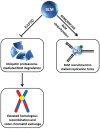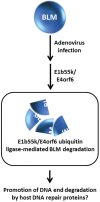Protein degradation pathways regulate the functions of helicases in the DNA damage response and maintenance of genomic stability
- PMID: 25906194
- PMCID: PMC4496686
- DOI: 10.3390/biom5020590
Protein degradation pathways regulate the functions of helicases in the DNA damage response and maintenance of genomic stability
Abstract
Degradation of helicases or helicase-like proteins, often mediated by ubiquitin-proteasomal pathways, plays important regulatory roles in cellular mechanisms that respond to DNA damage or replication stress. The Bloom's syndrome helicase (BLM) provides an example of how helicase degradation pathways, regulated by post-translational modifications and protein interactions with components of the Fanconi Anemia (FA) interstrand cross-link (ICL) repair pathway, influence cell cycle checkpoints, DNA repair, and replication restart. The FANCM DNA translocase can be targeted by checkpoint kinases that exert dramatic effects on FANCM stability and chromosomal integrity. Other work provides evidence that degradation of the F-box DNA helicase (FBH1) helps to balance translesion synthesis (TLS) and homologous recombination (HR) repair at blocked replication forks. Degradation of the helicase-like transcription factor (HLTF), a DNA translocase and ubiquitylating enzyme, influences the choice of post replication repair (PRR) pathway. Stability of the Werner syndrome helicase-nuclease (WRN) involved in the replication stress response is regulated by its acetylation. Turning to transcription, stability of the Cockayne Syndrome Group B DNA translocase (CSB) implicated in transcription-coupled repair (TCR) is regulated by a CSA ubiquitin ligase complex enabling recovery of RNA synthesis. Collectively, these studies demonstrate that helicases can be targeted for degradation to maintain genome homeostasis.
Figures












Similar articles
-
The helicase FBH1 is tightly regulated by PCNA via CRL4(Cdt2)-mediated proteolysis in human cells.Nucleic Acids Res. 2013 Jul;41(13):6501-13. doi: 10.1093/nar/gkt397. Epub 2013 May 15. Nucleic Acids Res. 2013. PMID: 23677613 Free PMC article.
-
FBW7 regulates DNA interstrand cross-link repair by modulating FAAP20 degradation.Oncotarget. 2016 Jun 14;7(24):35724-35740. doi: 10.18632/oncotarget.9595. Oncotarget. 2016. PMID: 27232758 Free PMC article.
-
[DNA helicases and human diseases].Med Sci (Paris). 2006 Dec;22(12):1087-94. doi: 10.1051/medsci/200622121087. Med Sci (Paris). 2006. PMID: 17156731 Review. French.
-
DNA helicases, genomic instability, and human genetic disease.Annu Rev Genomics Hum Genet. 2000;1:409-59. doi: 10.1146/annurev.genom.1.1.409. Annu Rev Genomics Hum Genet. 2000. PMID: 11701636 Review.
-
Replication stress induced site-specific phosphorylation targets WRN to the ubiquitin-proteasome pathway.Oncotarget. 2016 Jan 5;7(1):46-65. doi: 10.18632/oncotarget.6659. Oncotarget. 2016. PMID: 26695548 Free PMC article.
Cited by
-
History of DNA Helicases.Genes (Basel). 2020 Feb 27;11(3):255. doi: 10.3390/genes11030255. Genes (Basel). 2020. PMID: 32120966 Free PMC article. Review.
-
The Polymorphisms with Cataract Susceptibility Impair the EPHA2 Receptor Stability and Its Cytoprotective Function.J Ophthalmol. 2015;2015:401894. doi: 10.1155/2015/401894. Epub 2015 Nov 19. J Ophthalmol. 2015. PMID: 26664742 Free PMC article.
-
REV7 confers radioresistance of esophagus squamous cell carcinoma by recruiting PRDX2.Cancer Sci. 2019 Mar;110(3):962-972. doi: 10.1111/cas.13946. Epub 2019 Feb 8. Cancer Sci. 2019. PMID: 30657231 Free PMC article.
-
Mutations in ANAPC1, Encoding a Scaffold Subunit of the Anaphase-Promoting Complex, Cause Rothmund-Thomson Syndrome Type 1.Am J Hum Genet. 2019 Sep 5;105(3):625-630. doi: 10.1016/j.ajhg.2019.06.011. Epub 2019 Jul 11. Am J Hum Genet. 2019. PMID: 31303264 Free PMC article.
-
A game of substrates: replication fork remodeling and its roles in genome stability and chemo-resistance.Cell Stress. 2017 Dec;1(3):115-133. doi: 10.15698/cst2017.12.114. Epub 2017 Dec 5. Cell Stress. 2017. PMID: 29355244 Free PMC article.
References
Publication types
MeSH terms
Substances
Grants and funding
LinkOut - more resources
Full Text Sources
Other Literature Sources
Medical

